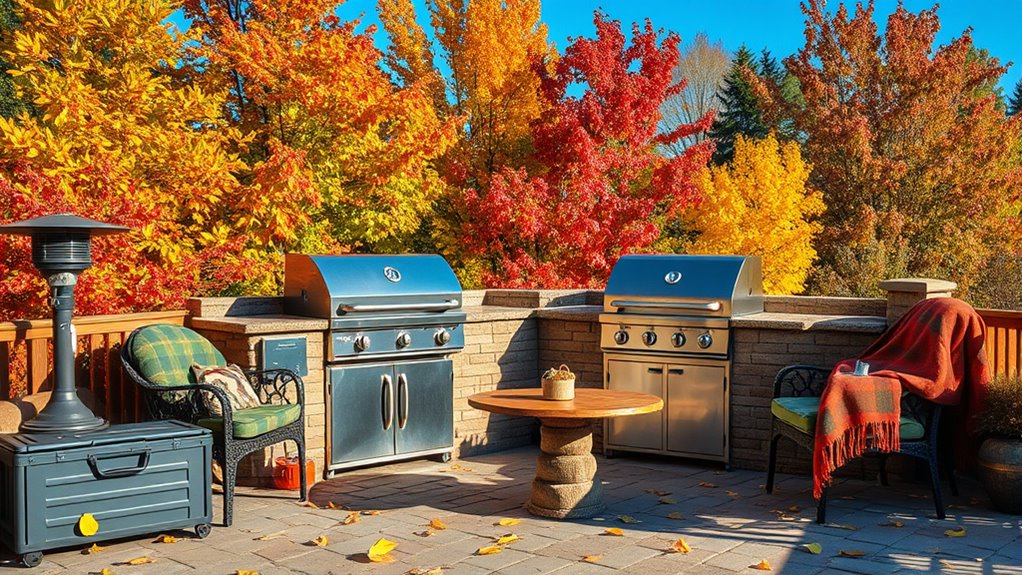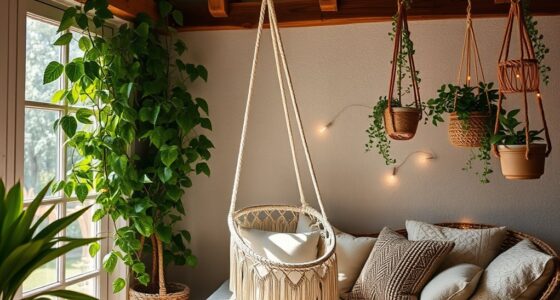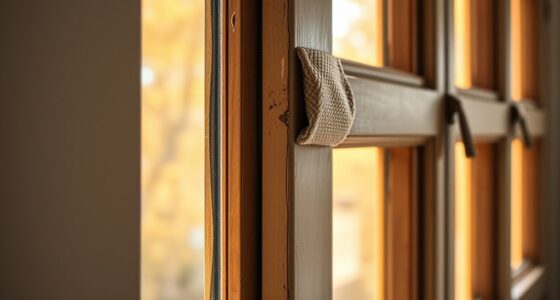In early October, you should thoroughly clean all cooking surfaces and appliances, removing grease and debris, then dry them completely. Cover outdoor furniture with waterproof, breathable covers and store cushions indoors. Drain and cap plumbing and gas lines to prevent leaks and pests. Apply protective sealants to surfaces like countertops and wood furniture. Finally, inspect everything for damage and decide whether to store your equipment indoors or cover it securely outside. Continuing will guide you through each step in detail.
Key Takeaways
- Thoroughly clean all cooking surfaces, appliances, and utensils to remove food residues and prevent pests.
- Cover outdoor furniture with waterproof, breathable covers and store cushions indoors or in sealed bins.
- Drain and disconnect plumbing and gas lines, then cap to prevent leaks, pests, and moisture entry.
- Apply outdoor sealants to countertops and surfaces, focusing on seams and joints for added protection.
- Conduct a final inspection, ensure all equipment is properly covered or stored, and verify gas lines are shut off.
Clear and Clean Your Cooking Surfaces and Appliances

Before winter sets in, it is essential to clear and clean your outdoor cooking surfaces and appliances. Start by removing any food residues, grease, and crumbs to prevent pests and mold growth. Scrub grills, countertops, and prep stations with a suitable cleaner to eliminate built-up grime. Pay special attention to burners and vents, making sure they’re free of debris that could cause blockages or corrosion. Wipe down all surfaces with a damp cloth, then dry thoroughly to prevent rust. If your appliances have removable parts, take them out and clean separately. Inspect for any damage or rust spots that need repair. Proper cleaning now helps maintain your equipment’s longevity and guarantees it’s ready for use when warmer weather returns. Additionally, consider the horsepower of your outdoor electric equipment to ensure it has sufficient power for your needs during the upcoming season. Recognizing the importance of home maintenance can also help you identify other areas needing attention before winter. Taking the time to prevent rust on metal surfaces can further extend the lifespan of your outdoor appliances. Performing a thorough equipment inspection now can help catch small issues before they become costly repairs. Incorporating routine preventative measures can also safeguard your equipment against harsh winter conditions.
Protect and Cover Your Outdoor Furniture and Accessories

As winter approaches, protecting your outdoor furniture and accessories is essential to preserve their condition. Start by cleaning everything thoroughly to remove dirt, dust, and debris. Once clean, cover your furniture with waterproof, weather-resistant covers to shield against snow, rain, and ice. If possible, use breathable covers to prevent mold and mildew buildup. For items like cushions or pillows, store them indoors or in sealed plastic bins to avoid moisture damage. Consider elevating furniture off the ground with pallets or blocks to prevent contact with standing water. Secure covers tightly with bungee cords or straps to prevent them from blowing away during storms. Proper protection now will help extend the life of your outdoor pieces and keep them looking great for seasons to come. Additionally, inspecting your filtration systems can help maintain the cleanliness of your outdoor space. Regularly checking and replacing filter screens ensures optimal airflow and reduces debris buildup, which is especially important before winter. Using UV filters can also help protect outdoor furniture and accessories from sun damage during the warmer months when they are still in use. Incorporating vertical storage solutions can further maximize space and keep items organized and protected from the elements.
Drain and Seal Plumbing and Gas Lines
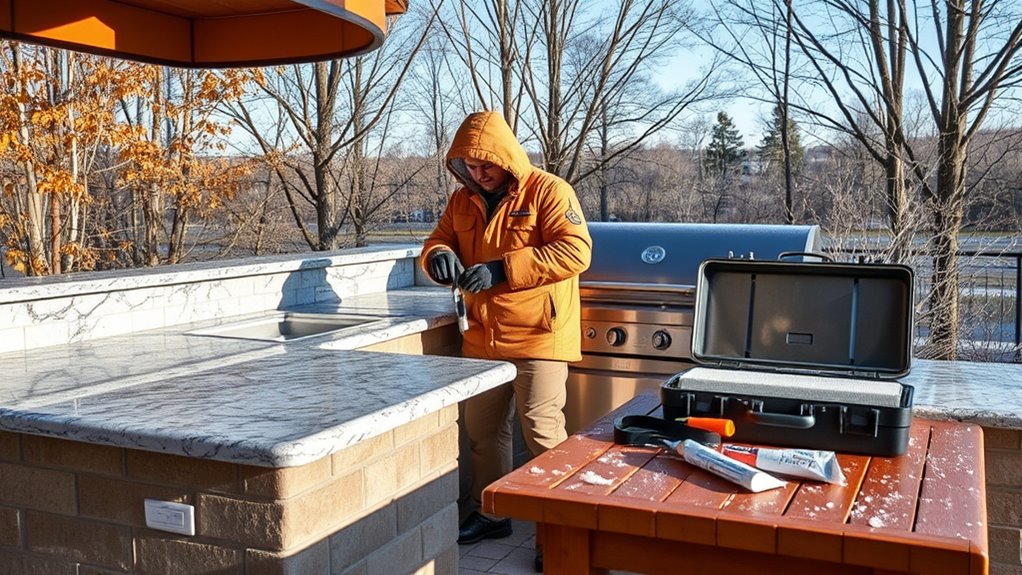
Have you made certain that your plumbing and gas lines are properly drained and sealed before winter? Start by turning off the main water supply and opening all faucets to drain remaining water. Use a wet/dry vacuum to suck out any leftover water from drains and traps. For gas lines, shut off the gas supply and disconnect appliances, then cap the lines securely to prevent moisture and debris from entering. Inspect all connections for leaks or damage and repair as needed. Applying caps or plugs to pipes and gas lines ensures no water or pests can get inside during freezing temperatures. Properly drained and sealed lines protect your outdoor kitchen from freezing damage, saving you time and money come spring.
Apply Protective Coatings and Sealants to Surfaces
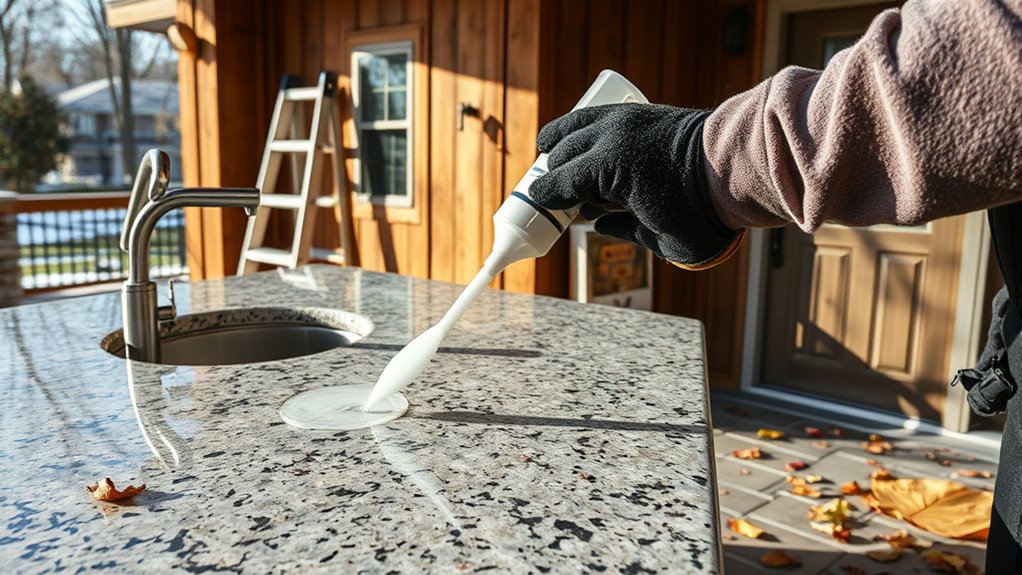
Applying protective coatings and sealants to your outdoor kitchen surfaces is essential to prevent damage from harsh winter conditions. Start by thoroughly cleaning all surfaces to remove dirt, grease, and debris. Allow them to dry completely. Use a high-quality sealant suited for outdoor use on countertops, stone, wood, or metal surfaces. Apply the sealant evenly with a brush or roller, following the manufacturer’s instructions. Pay special attention to seams, joints, and edges where water can seep in. Reapply as needed, especially if you notice areas where the coating has worn thin. This extra layer of protection helps prevent cracking, warping, and corrosion caused by moisture, snow, and ice. Proper sealing guarantees your outdoor kitchen remains in good condition until you’re ready to use it again. Incorporating outdoor elements like plants into your decor can also help shield surfaces from the elements and provide additional insulation. For added durability, consider using weather-resistant protective coatings designed specifically for outdoor furniture and fixtures.
Perform a Final Inspection and Store or Cover Equipment
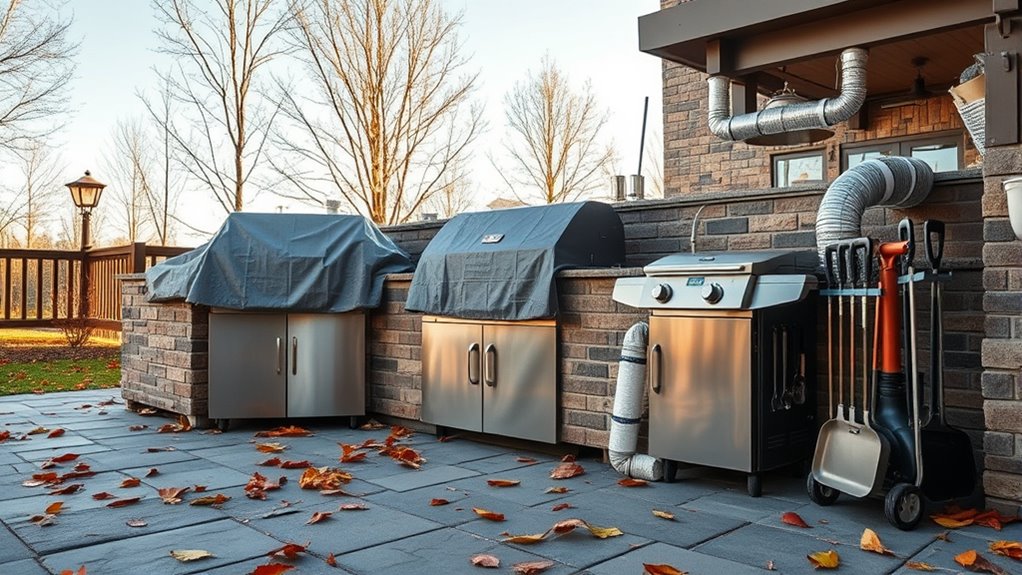
Before storing or covering your outdoor kitchen for winter, it’s important to perform a thorough final inspection. Check all surfaces, appliances, and fixtures for damage or debris. Look for rust, cracks, or leaks that could worsen over time. Confirm all gas lines are shut off and vents are clear. Once inspected, decide whether to store equipment indoors or cover it securely outside. Use high-quality covers that fit snugly to prevent snow, moisture, and pests from getting in. Proper storage preserves your equipment and extends its lifespan. Additionally, inspecting your air quality during this process can help identify potential issues before they worsen. Considering the local climate conditions can also guide you in choosing the most effective winterization strategies. Conducting a lifestyle assessment of your outdoor space can help optimize your winterization approach and ensure your setup remains in top condition for the seasons ahead. Checking your retail store hours can ensure you have all necessary supplies on hand for winterization. Being aware of beauty store hours can help you plan your shopping trips efficiently.
Frequently Asked Questions
When Is the Best Time to Start Winterizing My Outdoor Kitchen?
You should start winterizing your outdoor kitchen when the weather begins to consistently drop below freezing, typically in late fall. Keep an eye on the forecast and plan to prep your space before heavy frosts arrive. This way, you can safeguard your appliances and plumbing. Acting early ensures you avoid damage from ice and snow, saving you time and money come spring.
Can I Winterize Outdoor Appliances Without Professional Help?
You can winterize outdoor appliances yourself if you’re comfortable with basic maintenance tasks. Start by turning off the water supply, draining all pipes, and disconnecting hoses. Use a shop vac or compressed air to clear out remaining water from appliances. Follow manufacturer instructions carefully, and don’t hesitate to call a professional if you’re unsure about any step. Proper winterization helps prevent damage and extends the life of your outdoor kitchen.
How Do I Prevent Pest Infestations During Winter Storage?
Pests lurking in your outdoor kitchen can turn winter storage into a nightmare. Before storing, clean thoroughly, removing food residues and debris that attract bugs and rodents. Seal all openings, use pest-repellent sprays, and consider placing traps nearby. While winterizing your appliances, don’t forget to take these pest prevention steps; they’re essential to keep critters out and ensure your outdoor kitchen stays pest-free until spring.
What Safety Precautions Should I Take During Winterization?
During winterization, you should prioritize safety to protect yourself and your property. Always wear gloves and protective eyewear when handling cleaning agents or tools. Disconnect and drain appliances to prevent freezing damage, and make certain the area is well-ventilated if using chemicals. Keep children and pets away from equipment and chemicals. Follow manufacturer instructions carefully, and use proper lifting techniques to avoid injury. Staying cautious helps guarantee a safe, effective winterization process.
How Often Should I Inspect My Outdoor Kitchen During Winter?
Think of your outdoor kitchen as a vigilant guard dog, always alert and ready. You should inspect it at least once a month during winter, especially after storms or heavy snowfall. Look for signs of wear, rust, or trapped moisture that could cause damage. Regular checks help you catch issues early, ensuring your outdoor kitchen stays safe, functional, and ready to serve you when spring arrives.
Conclusion
By following these winterization steps, you’re not just protecting your outdoor kitchen—you’re ensuring it stays in top shape for years to come. Think of it as giving your space a well-deserved rest, so it’s ready to shine again when warmer days return. Some believe that properly winterized outdoor spaces can even extend their lifespan, saving you money and effort long-term. So, take these simple actions now and enjoy a worry-free, prepared outdoor kitchen come spring.
